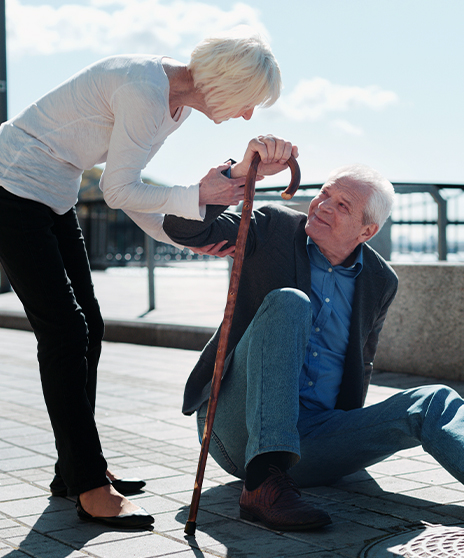The risks of falling and how to prevent them.
Falls among older adults are common. According to the Centers for Disease Control and Prevention (CDC), one adult over the age of 65 falls every second of every day in the United States (U.S.) leading to a reported 36 million falls and resulting in over 32,000 deaths each year. Learn about the risk factors contributing to falls and the preventative measures that can reduce your chances of fall-related injuries and deaths.
What are the risks? How can you reduce them?
There are several risks that can increase the likelihood of falls. Here are five of the most common factors leading to falls in the senior population:
Balance – Difficulties with walking or loss of balance
To improve balance, it’s important to stay active and do exercises that strengthen your legs. Try going for a walk, swimming or practicing yoga.
Vision – As we age, our vision deteriorates and can be affected by common diseases like glaucoma or cataracts
Make an appointment with an eye doctor at least once every year and make sure to keep your eyeglasses up to date. If you have diabetes, you also need to get your annual diabetic eye exam to check for retinopathy.
Hearing – Similar to vision, hearing loss is a natural part of the aging process and causes people to be less aware of their surroundings. A 2013 study found that there is a significant association between hearing loss and reported falls.
Addressing hearing loss is important to help in the prevention of falls among older people. Hearing aids should be used even for mild hearing loss both outside and inside the home while carrying out daily activities and when other people and pets in the background may go unnoticed.
Medications – The use of prescriptions and over-the-counter medications can have negative side effects that impact balance, such as dizziness.
Talk to your doctor about reviewing any medications you are using to determine if they can cause dizziness or drowsiness. Additionally, make sure to take your medications exactly as directed.
Home safety – Trip hazards around the household like uneven steps, wires and low lighting increase the risk of falling
Make your home safer by getting rid of any clutter you can trip over, adding non-slip rubber treads on stairs and changing out old lightbulbs and adding nightlights in dark areas. The CDC provides a Check for Safety brochure that helps identify and remove fall hazards in the household.
Incontinence or other conditions that prompt rushed movement to the bathroom can also increase the risk of falling. Read our blog on urinary incontinence for tips on how to get it under control and improve your safety.
Chronic conditions – A CDC study found that 85% of adults age 65 and over have at least one chronic health condition, which can increase the risk of falling according to the National Council on Aging.
Stay active, maintain a healthy weight and stick to a regular sleeping schedule to help prevent falls when managing chronic conditions.
Exercising, monitoring medications and removing hazards in the home are simple, effective ways to prevent a fall. If you experience a fall, it’s important to schedule an appointment with your medical provider to be assessed for any injury.
Book an appointment today.
Book an appointment with your primary care provider today. Don’t have a healthcare provider? Book an appointment with one of our P3 Medical Group providers.


